The Intel Core i5-7600K (91W) Review: The More Amenable Mainstream Performer
by Ian Cutress on January 3, 2017 12:01 PM EST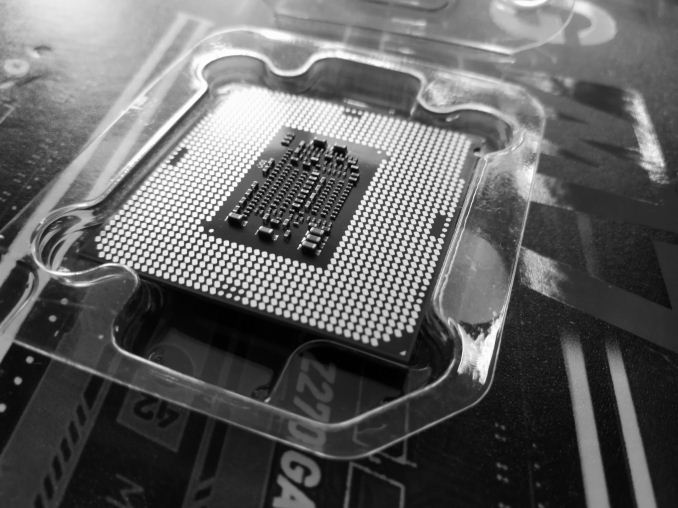
The Core i5-7600K, launched today, is the other unlocked processor from Intel’s 7th Generation line of Kaby Lake Processors. Kaby Lake is Intel’s third set of processors at 14nm, using the new 14+ process variant, which aims to give processors with a better frequency / voltage curve that translates into more performance, better efficiency, and the potential to push the silicon further and harder. Here is our review.
The Core i5 Doesn’t Get The Glory
One of the big debates in a lot of online PC performance forums is the Core i5 vs Core i7 debate. On the one hand we have a cheaper processor with four cores, while the other has hyperthreading and costs more. The argument always steers towards whether hyperthreading actually works, whether it is needed, whether the cost justifies it, or if it makes any difference in the workload for that user. Bearing in mind that many users will defend the hardware choice they paid their own money for, it easily becomes a slinging match if users cannot understand individual use cases. That’s typically where objective reviews, either written or video, come into effect. There are a number of YouTube channels that cite an i5 vs i7 review as their biggest (or one of their biggest, minus a video on a truck) reviews.
Ultimately it comes down to this: in most cases, the Core i5 will perform equal or reasonably equal to the Core i7, especially when it comes to gaming. As a result, there’s no need to spend the extra, especially given that the Core i7 typically comes at a large ($50-$100) premium, which could be better spent getting an SSD or a better graphics card.
In the case of the Core i5-7600K, the matter is compounded by both the presence of Skylake and the frequency settings of the 7600K itself. From other testing (see our extensive Kaby Lake coverage), we’ve shown that Kaby Lake offers little-to-no clock-for-clock gain in performance – a Skylake at 4 GHz performs the same as a Kaby Lake at 4 GHz. So technically an out-of-the-box Core i5-7600K will perform similarly to a mildly overclocked Core i5-6600K, albeit at lower power (Kaby Lake has efficiency benefits due to a better voltage/frequency profile). If a user cares more about performance than power, then they might as well pick up an i5-6600K cheap when retailers start reducing their stock.
On top of this, the frequency difference between the Core i5-7600K and Core i7-7700K is somewhat larger than normal. Starting with the i5 at 4.0 GHz base with a 4.2 GHz turbo, the Core i7-7700K starts with 4.2 GHz base with a 4.5 GHz turbo. At no point do the two intersect, and there could arguably by a 500 MHz difference in performance. That might actually start to get noticeable in some frequency bound gaming.
So while the Core i5 doesn’t get the glory, the Core i5-7600K has more of an uphill struggle than most Core i5 parts in recent memory.
Meet Kaby Lake i5-K
Intel's 7th Generation of Core CPUs, which often goes by its internal code name 'Kaby Lake', stretches from 91W on the mainstream desktop down to 4.5W for notebook processors, all using the same underlying technology in different core and integrated graphics configurations. The i7-7700K is the top part of this processor family, featuring four cores with hyperthreading, and we move down through the Core i5 and Core i3 parts. This time there are three overclocking processors, with the new one being the Core i3-7350K. That CPU is the subject of another review.
| Intel Kaby Lake S SKUs | |||||||
| Cores Threads |
Base Turbo |
IGP | L3 | eDRAM | TDP | Cost | |
| i7-7700K | 4/8 | 4.2/4.5 | HD 630 | 8 MB | - | 91 W | $305 |
| i7-7700 | 4/8 | 3.6/4.2 | HD 630 | 8 MB | - | 65 W | $272 |
| i7-7700T | 4/8 | 2.9/3.8 | HD 630 | 8 MB | - | 35 W | $272 |
| i5-7600K | 4/4 | 3.8/4.2 | HD 630 | 6 MB | - | 91 W | $217 |
| i5-7600 | 4/4 | 3.5/4.1 | HD 630 | 6 MB | - | 65 W | $199 |
| i5-7600T | 4/4 | 2.8/3.7 | HD 630 | 6 MB | - | 35 W | $199 |
| i5-7500 | 4/4 | 3.4/3.8 | HD 630 | 6 MB | - | 65 W | $179 |
| i5-7500T | 4/4 | 2.7/3.3 | HD 630 | 6 MB | - | 35 W | $179 |
| i5-7400 | 4/4 | 3.0/3.5 | HD 630 | 6 MB | - | 65 W | $170 |
| i5-7400T | 4/4 | 2.4/3.0 | HD 630 | 6 MB | - | 35 W | $170 |
| i3-7350K | 2/4 | 4.2 | HD 630 | 4 MB | - | 60 W | $157 |
| i3-7320 | 2/4 | 4.1 | HD 630 | 4 MB | - | 51 W | $139 |
| i3-7300 | 2/4 | 4.0 | HD 630 | 4 MB | - | 51 W | $129 |
| i3-7300T | 2/4 | 3.5 | HD 630 | 4 MB | - | 35 W | $129 |
| i3-7100 | 2/4 | 3.9 | HD 630 | 3 MB | - | 51 W | $109 |
| i3-7100T | 2/4 | 3.4 | HD 630 | 3 MB | - | 35 W | $109 |
At a tray price of $217, the Core i5-7600K is quite a saving over the overclockable i7 which is $303, meaning an $86 tray price difference off the bat. For users on a budget, that could be the difference between a good RX 460 and a cheap RX 480, or moving to a 256GB storage drive over a 128GB one. Despite the price difference, it is more the performance that draws the K processors, which will be the subject of this review.
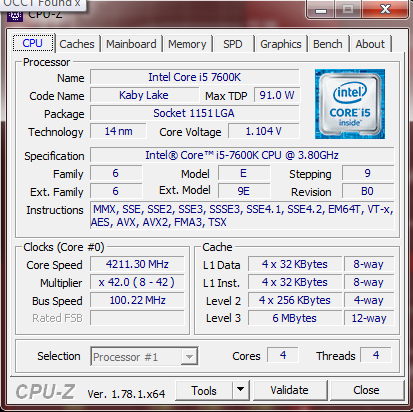
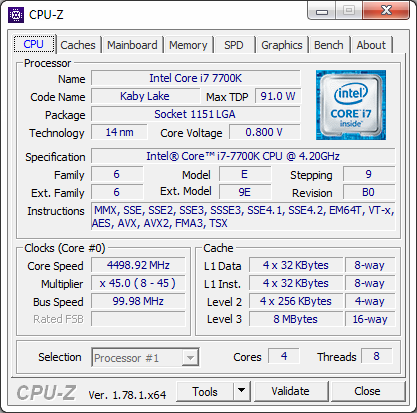
Intel Core i5-7600K (left) vs Intel Core i7-7700K (right)
The differences between the Core i7 and Core i5 are similar to those from previous generations – no hyperthreading on the Core i5, and a reduced L3 cache from 8 MB to 6 MB. Aside from the frequency difference, this element of cache could also come into play in memory heavy benchmarks, such as WinRAR.
Comparing it to the previous generation i5-6600K Skylake processor, we get the same configuration of cache hierarchy. The main difference between the two will be support for DDR4-2400 on the Kaby Lake rather than DDR4-2133, updated integrated graphics, a new generation of Speed Shift, AVX Offset support, and support for Intel’s ‘Optane Memory’.
Speed Shift v2
For the Intel’s 6th Generation of processors, Skylake, they introduced Speed Shift (v1). This was a feature that, at a high level, gave control of the voltage/frequency curve from the operating system to the processor. Using a series of internal metrics, such as instruction analysis and frequency, the CPU would automatically adjust the voltage and frequency of the processor as required. This afforded two major benefits: one, with the CPU in control it has access to many more points on the curve compared to the OS which is limited to specific P-states on the processor.
The second benefit is the speed of transition. A processor that can ramp up to a high frequency quickly and then drop down as needed can get through instructions quicker but also save power. Imagine driving a car, and having to wait 60 seconds to change a gear – it’s that sort of analogy.
What Speed Shift v2 does in the Kaby Lake family, compared to v1 in Skylake, is manage those transitions to higher frequency faster. Before Speed Shift, transitions from idle to peak turbo were on the order of 100 milliseconds, and Speed Shift v1 took that to 30 milliseconds (with a good base established within 15). Speed Shift v2 means that peak performance from idle now happens in 10-15 milliseconds total. This means that interactions with the OS, such as touch, or actions that rely on low latency, can occur within a couple of frames on a 60 Hz display.
The benefit of Speed Shift lies a lot in touch devices, which perhaps doesn’t affect the desktop Kaby Lake processors in this review, but also in web interactions. A lot of web work is stop and start, such as scrolling or javascript functions.
There is one caveat however – Speed Shift currently only works in Windows 10. It requires a driver which is automatically in the OS (v2 doesn’t need a new driver, it’s more a hardware update), but this limitation does mean that Linux and macOS do not benefit from it. I would be hard pressed to not imagine that Apple and Intel were not working on a macOS driver, but as yet we have not had confirmation that one exists.
Optane Memory Support
The latest memory technology to hit prime time is Intel and Micron’s 3D XPoint. This is a non-volatile form of data storage that is bit addressable and can be used as DRAM or storage. Despite being at least a decade in the making, and being formally announced in 2014, it is still yet to show up commercially as it is still being developed. Intel plans to create 3D XPoint DRAM that is slightly slower than normal DRAM but both denser (more of it) and non-volatile (keeps the data after power loss, saves power altogether), as well as 3D XPoint Storage that is faster than standard NAND flash, and more configurable. It the scheme of things, we expect the storage based products to hit the market first.
Intel, as far as we can tell, is set to release two main classes of product: Optane DRAM to be pin-compatible with DDR4 and require Optane DRAM enabled processors, and Optane SSDs which should work with any PCIe storage interface. ‘Optane Memory’ however, is something a little different. Based on pre-briefings, Optane Memory is certainly not Optane SSD we were told, but rather a storage cache for mechanical hard-drives. We’ve had this before with NAND flash drives, using Intel’s Rapid Storage Technology, and it seems that Kaby Lake and 200-series chipsets will support a new version of RST for PCIe-based storage. But because this is caching drive, such as the 16GB Optane Memory drives in Lenovo’s upcoming notebooks, and not Optane SSD, might lead us to believe that ‘Optane Memory’ drives are not designed to be directly user addressable.
All that being said, Intel has stated that Optane Memory standalone drives should hit the market nearer Q3 for general consumer use, which is more in-line with what we might expect to see with Optane SSDs in the enterprise space.
More about Kaby Lake
For readers that want a more in-depth take on Kaby Lake as a platform, we have a dedicated article full of information for you. We also have other articles in our Kaby Lake bonanza for launch day.
Other articles include:
Intel Launches 7th Generation Kaby Lake (Overview and Core Improvements)
The Intel Core i7-7700K Review: The New Out-of-the-box Performance Champion
The Intel Core i5-7600K Review: The More Amenable Mainstream Performer
The Intel Core i3-7350K Review: When a Core i3 Nearly Matches the Core i7-2600K
Upcoming (we’re at CES and didn’t have time to finish these yet):
Calculating Generational IPC Changes from Sandy Bridge to Kaby Lake
Intel Core i7-7700K, i5-7600K and i3-7350K Overclocking: Hitting 5.0 GHz on AIR
Intel Launches 200-Series Chipset Breakdown: Z270, H270, B250, Q250, C232
Intel Z270 Motherboard Preview: A Quick Look at 80+ Motherboards



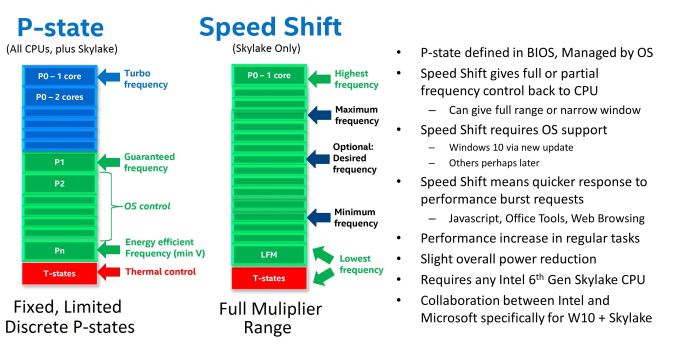
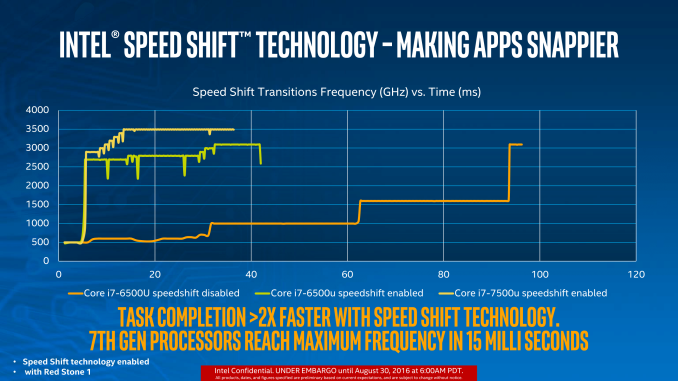
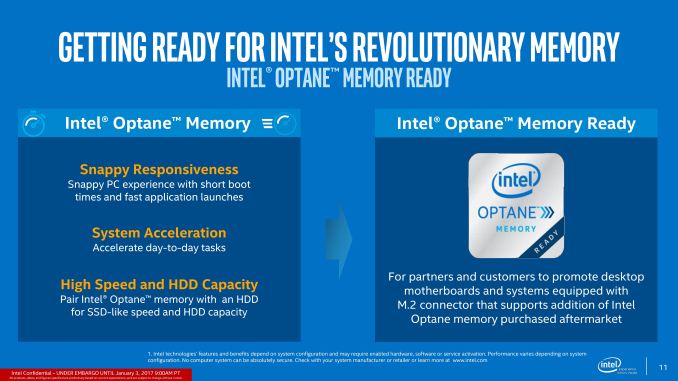








70 Comments
View All Comments
Magichands8 - Tuesday, January 3, 2017 - link
This Optane looks completely useless. But Optane DRAM sounds like it could be interesting. Depending upon how much slower it is.lopri - Wednesday, January 4, 2017 - link
I immediately thought of "AMD Memory" which AMD launched after the Bulldozer flop. But then again Intel have been going after this storage caching scheme for years now and I do not think it has taken them anywhere.smilingcrow - Tuesday, January 3, 2017 - link
Games frame rates to 2 decimal points adds nothing but making it harder to scan the numbers quickly. Enough already.1_rick - Tuesday, January 3, 2017 - link
One place where the extra threads of an i7 are useful is if you're using VMs (maybe to run a database server or something.) I've found that an i5 with 8GB can get bogged down pretty drastically just from running a VM.Meteor2 - Tuesday, January 3, 2017 - link
I kinda think that if you're running db VMs on an i7, you're doing it wrong.t.s - Wednesday, January 4, 2017 - link
or if you're Android developer using Android Studio.lopri - Wednesday, January 4, 2017 - link
That is true but as others have implied you can get 6 or 8 real core Xeons for cheaper than these new Kaby Lake chips if VM is what you need the performance of a CPU is for.ddhelmet - Tuesday, January 3, 2017 - link
Well I am more glad now that I got a Skylake. Even if I waited for this the performance increase is not worth it.Kaihekoa - Tuesday, January 3, 2017 - link
Y'all need to revise your game benchmarking analysis. At least use some current generation GPUs, post the minimum framerates, and test at 1440p. The rest of your review is exceptional, but the gaming part needs some modernization, please.lopri - Wednesday, January 4, 2017 - link
I thank the author for a clear yet thorough review. A lot of grounds are covered and the big picture of the chip's performance and features is well communicated. I agree with the author's recommendation at the end as well. I have not felt that I am missing out anything compared to i7's while running a 2500K for my gaming system, and unless you know for certain that you can take advantage of HyperThreading, spending the difference in dollars toward an SSD or a graphics card is a wiser expenditure that will provide you with better computing experience.Having said that, I am wtill not compelled to upgrade my 2500K which has been running at 4.8 GHz for years. (It does 5.0 GHz no problem but I run it at 4.8 to leave some "headroom") While I think the 7600K is barely a worthy upgrade (finally!) on its own light, but the added cost cannot be overlooked. A new motherboard, new memory, and potentially a new heat sink will quickly add to the budget, and I am not sure if it is going to be worth all the expenses that will follow.
Of course all that could be worthwhile if overclocking was fun, but Intel pretty much have killed overclocking and the overclocking community. Intentionally if I might add. Today overclocking does not give one a sense of discovery or accomplishment. Competition between friendly enthusiasts or hostile motherboard/memory vendors has disappeared. Naturally there is no accumulation or exchange of knowledge in the community, and conversations have become frustrating and vain due to lack of overclocking expertise. Only some brute force overclocking with dedicated cooling has some following, and the occasional "overclocking" topics in the forums are really a braggadocio in disguise, of which the competition underneath is really about who spent the most on their rigs with the latest blingy stuff. Needless to say those are not as exciting or illuminating as the real overclocking of the yore, and in my opinion there are better ways to spend money for such a self-gratification without the complication that often accompanies overclocking which in the end fails to impress.
Intel might have a second thought about its overclocking policies now, but just as many things Intel have done in recent years, it is too little too late. And their chips have no headroom anyway. My work system is due for an upgrade and I am probably going to pick up a couple of E2670s which will give me 16 real cores for less than $200. Why bother with the new stuff when the IPC gain is meager and there is no fun in overclocking? And contribute to Intel's revenue? Thank you but no thank you.
P.S. Sorry I meant to commend the author for the excellent (albeit redundant) review but ended up ranting about something else. Oh well, carry on..